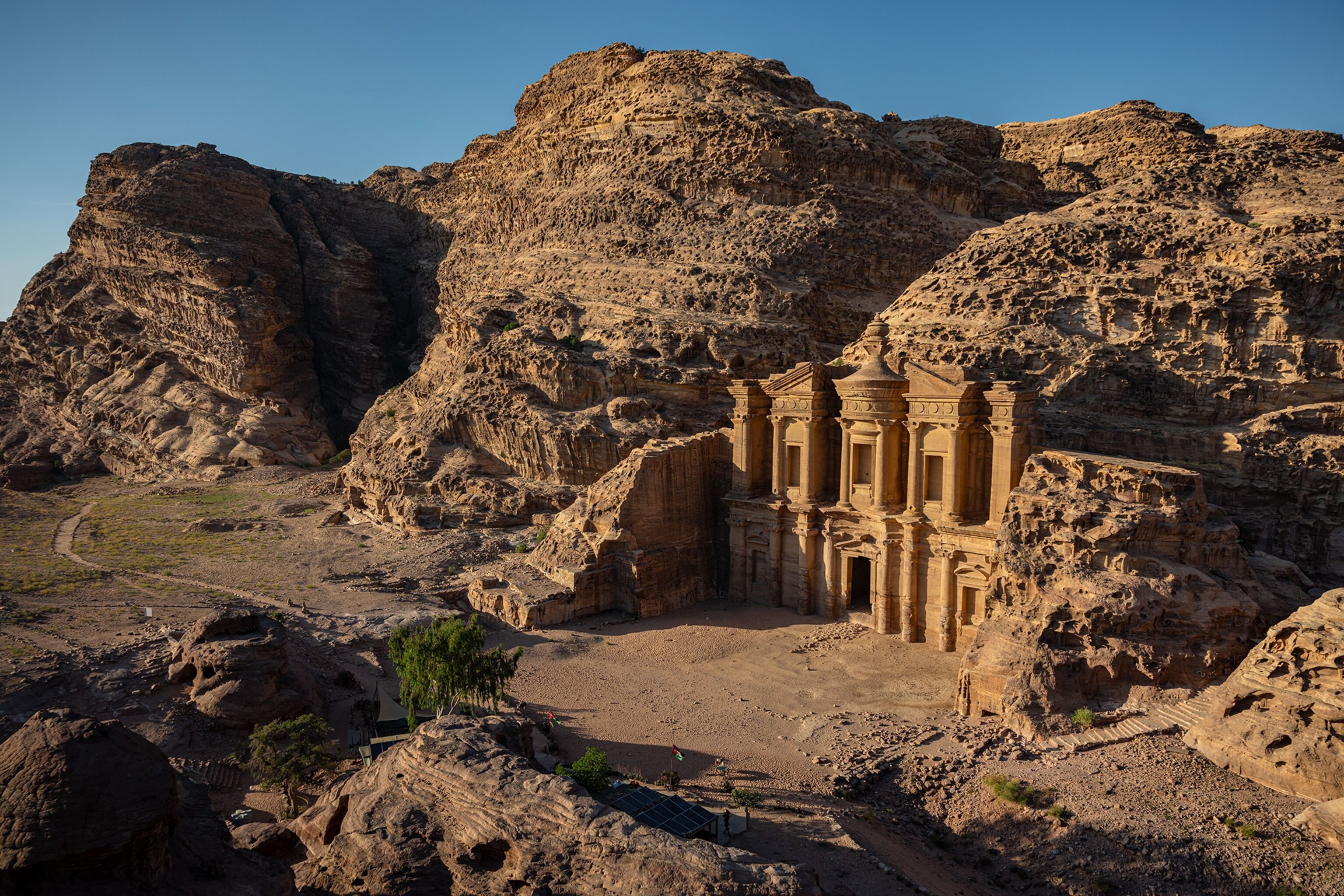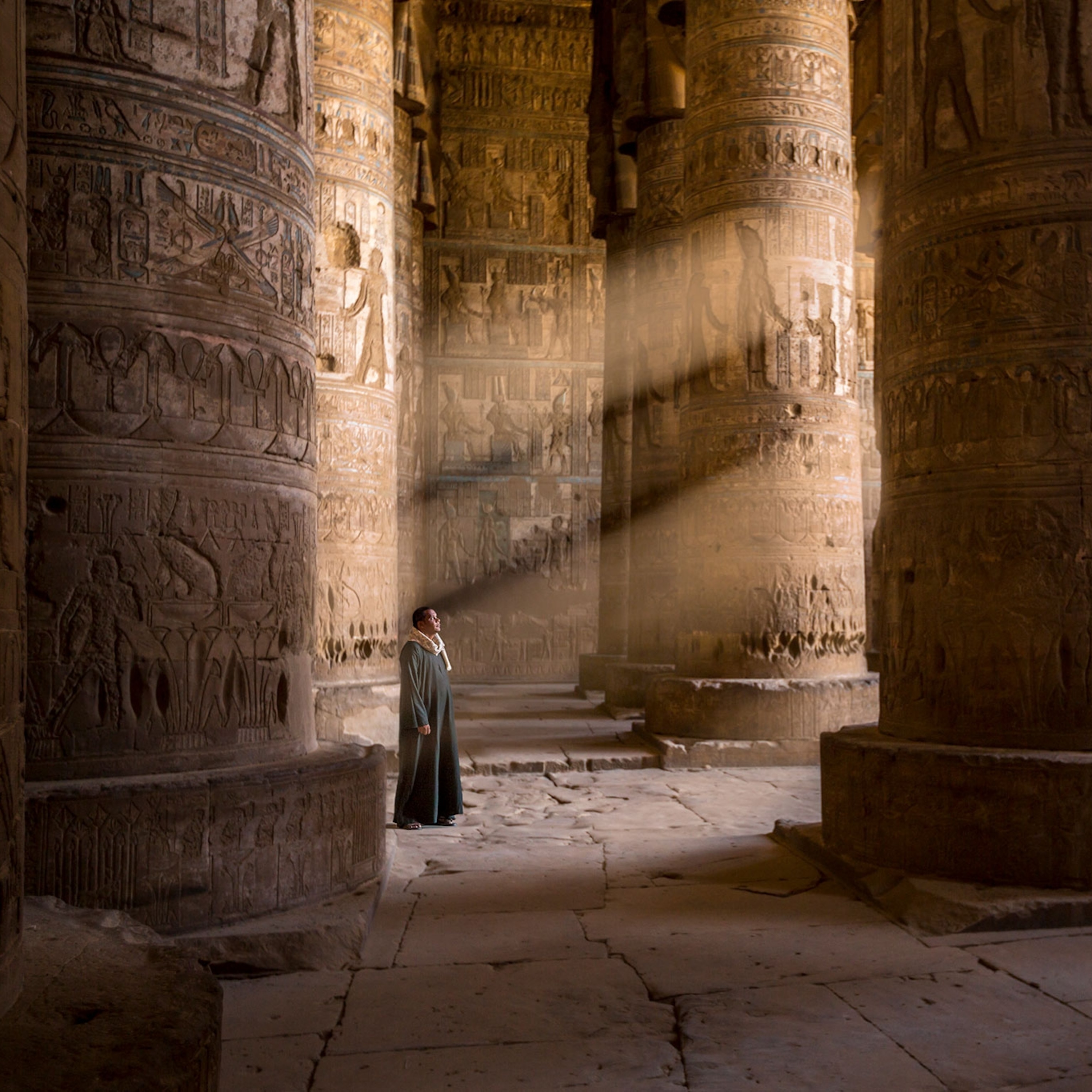The world’s historic sites face climate change. Can Petra lead the way?
The 2,000-year-old desert city created an adventurous backdrop for Indiana Jones, but today, drought, floods, and sandstorms imperil it. Ancient technology could be the key to surviving.

When he was a boy growing up in Wadi Musa, a town in southern Jordan, Mohamad Alfarajat says his father told him stories of green terraces planted with wheat in the region’s desert canyons, along with thriving apricot orchards and fig trees that fed the local community.
Alfarajat, now a geologist at Al-Hussein Bin Talal University in nearby Ma’an, Jordan, says little of that bounty remains. Longer and longer dry spells have made it harder to maintain the fields that fed his father and generations before him.
“Since climate change started 40 years ago, the fertile areas started to contract,” Alfarajat says. “The community used to grow its own food on its own land, and now they import nearly everything from outside.”
As drought has made local agriculture precarious, climate change has also made flash flooding more frequent, threatening both the area’s ancient ruins and local communities. And more intense temperature swings have accelerated the weathering of historic sandstone facades that were carved at the height of the Roman Empire.
“The impact of climate change at Wadi Musa is very clear,” says Alfarajat. “If you want to see climate change impacts in front of your face, come to Petra.”
Wadi Musa has changed in other ways since Alfarajat was a boy. Since the 1980s, the nearby archaeological site of Petra has turned into a global tourism hotspot. Nearly a million visitors visit Petra each year to marvel at the tombs and temples cut into sandstone by the Nabatean civilization almost 2,000 years ago. They, too, are threatened by flash floods, and damage to the archaeological site would endanger the tourism business locals have come to rely on.
To protect the site in decades to come, Petra’s guardians are turning to ancient solutions, including technology left behind by the people who originally built the remarkable desert outpost.

Adapting to floods
The mountains around Petra are shaped like a bowl, with the ancient city at the center. Elevation across the sprawling, 100-square-mile site varies by more than 3,000 feet. When it rains in the region, water quickly makes its way downhill—often resulting in catastrophic, even deadly, flash floods. People in the area still talk about the winter of 1963, when floods took people at the site by surprise and killed dozens of locals and tourists. In 2018, rushing water again sent boulders tumbling through the ravines around Wadi Musa.
As recently as December 2022, fast-moving walls of water coursed through Petra’s narrow canyons, sloshing muddy water all the way up to the steps of the iconic Treasury, an ancient building made famous as an exterior in “Indiana Jones and the Last Crusade.”
“Water came from four directions, directly into the Treasury,” says Taher Falahat, a cultural heritage expert at the Petra Development Tourism Regional Authority, the agency that manages Petra and the surrounding area.
Research shows the Nabateans, too, had to deal with seasonal flooding and drought. Desert traders who ruled the region until around 300 A.D., the Nabateans were a key link in the trade in luxury goods between the Roman Empire and their neighbors to the east. The features that made the area around Wadi Musa attractive for the ancient Nabateans—its winding canyons, high peaks and plateaus, and protected valleys—also make it vulnerable to flooding today. “They faced the same problems, they had the same topography,” Falahat says.
Archaeologists have spent decades tracing the ways Nabateans managed water in the region. They discovered that Nabatean engineers came up with an interlocking system of terraces and small dams to flood-proof ancient Petra. The elaborate system channels water through the many ravines and canyons in and around Petra and Wadi Musa. The dams slow the rushing water that leads to flooding, channeling it into storage ponds. Terraces, meanwhile, soaked up water and provided space for crops.
Once the Nabatean kingdom collapsed in the fourth century AD, the system was neglected and fell into disrepair. Even after Petra was rediscovered by archaeologists and developed as a tourist destination in the 20th century, researchers overlooked the dams, focusing instead on the magnificent architecture cut into the cliffs of Petra’s canyons. “They’ve been left alone for thousands of years,” Falahat says. “They’re all still there, they’ve just fallen apart.”
(The city of Rome wasn't built for today's climate. Is there time to save it?)
An ancient solution for a modern problem
Plans to revive them are part of the recommendations of a new, National Geographic Society-funded effort to help Petra and other cultural heritage sites around the world adapt to climate change. Called Preserving Legacies, the project aims to help communities protect their heritage sites from climate change. “We build local climate models and talk to community leaders about what’s most important to save,” says the project’s leader, geographer, and National Geographic Explorer Victoria Herrmann.
It’s a crucial effort. As the Earth’s climate shifts, once-in-a-century events like the deadly floods that hit Petra in 1963 are likely to get more frequent, with rainfall in the region increasing by an estimated 40 percent by 2050. “Flooding, which has always been part of Petra’s story, will get more intense,” Herrmann says.
That’s not the only risk Petra’s guardians must prepare for: Already at the limit of its desert ecosystem, the wheat and fruit orchards that remain will be further stressed by drought as temperatures steadily rise and heatwaves get more frequent. Sandstorms, too, are expected to increase in size, frequency, and severity, potentially eating away at the sandstone facades of Petra’s tombs and temples. Blowing sand and the dramatic changes in temperature between night and day, meanwhile, crack and crumble the sandstone structures.

In other parts of the world, sea level rise, drought, flooding, and other disasters threaten cultural sites in ways scientists are just beginning to understand. “There will be increasing drought and temperatures, and increasing floods,” says Salma Sabour, a physical and environmental engineer working as the Preserving Legacies project's science director. “What we can’t find in the science is the risk as perceived by communities and how they can respond.”
The Petra work is a sort of pilot project to show how adapting and responding to climate change can make a big difference to heritage sites. In a report released today, the Preserving Legacies team says the risks to Petra over the coming decades are moderate— “not because hazards are not there,” Sabour says, “but because the community and authorities have been exploring creative ways to adapt, and training people to respond.”
(Climate change is threatening Alaska's artifacts. Learn more.)
Adapting using “ancient wisdom”
The authorities who manage Petra and the surrounding area have put in place extensive training programs and evacuation drills to make sure park staff are prepared for floods. A digital warning system tracks rainfall and sounds an alarm when conditions are ripe for flooding.
During the floods that hit the site in late 2022, the preparation paid off—1,700 tourists and staff were evacuated from Petra in a matter of hours, with no reported injuries.
Lessons from the past are also being used to help adapt to extreme conditions in the future. “There is ancient wisdom physically built into the site,” Herrmann says. “Combined with modern solutions, that Nabatean water management system has the greatest potential for adapting Petra to flash floods.”
Over the past three years, Falahat has worked with people from the local community to repair and revive the Nabateans’ handiwork, cleaning and repairing the ancient dams and terraces. The work, which has to be repeated each year to clear mud and rocks that build up over the winter rainy season, creates employment while helping safeguard the site.
The effort has given Falahat a new appreciation for the work of the Nabateans. “Now my passion is Nabatean terraces,” he laughs. “They were geniuses at collecting water. Walking in the steps of the Nabateans, we can solve this problem.”
You May Also Like
Go Further
Animals
- He’s called ‘omacha,’ a dolphin that transforms into a man. Why?He’s called ‘omacha,’ a dolphin that transforms into a man. Why?
- Behind the scenes at America’s biggest birding festivalBehind the scenes at America’s biggest birding festival
- How scientists are piecing together a sperm whale ‘alphabet’How scientists are piecing together a sperm whale ‘alphabet’
- Orangutan seen using plants to heal wound for first timeOrangutan seen using plants to heal wound for first time
Environment
- He’s called ‘omacha,’ a dolphin that transforms into a man. Why?He’s called ‘omacha,’ a dolphin that transforms into a man. Why?
- The northernmost flower living at the top of the worldThe northernmost flower living at the top of the world
- This beautiful floating flower is wreaking havoc on NigeriaThis beautiful floating flower is wreaking havoc on Nigeria
- What the Aral Sea might teach us about life after disasterWhat the Aral Sea might teach us about life after disaster
- What La Palma's 'lava tubes' tell us about life on other planetsWhat La Palma's 'lava tubes' tell us about life on other planets
History & Culture
- This thriving society vanished into thin air. What happened?This thriving society vanished into thin air. What happened?
- These were the real rules of courtship in the ‘Bridgerton’ eraThese were the real rules of courtship in the ‘Bridgerton’ era
Science
- Is the 5-second rule true? Science finally has an answer.
- Science
- Gory Details
Is the 5-second rule true? Science finally has an answer. - E-bikes are good for the environment—but what about your health?E-bikes are good for the environment—but what about your health?
- Why trigger points cause so much pain—and how you can relieve itWhy trigger points cause so much pain—and how you can relieve it
Travel
- The story of this French village is set in stone — literallyThe story of this French village is set in stone — literally
- How to spend a long weekend in Zagreb, Croatia
- Paid Content
How to spend a long weekend in Zagreb, Croatia - The best LGBTQ-friendly destinations for every travelerThe best LGBTQ-friendly destinations for every traveler







